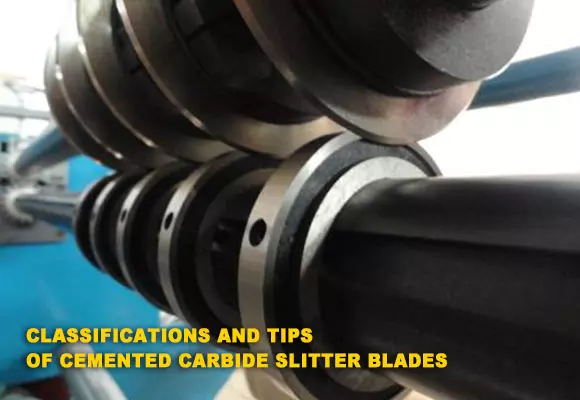
Classifications of Cemented Carbide Slitter Blades
Cemented carbide slitter blades are cutting tools with vital preciseness. It can lessen machine downtime. Tungsten carbide slitter blades are divided into the upper knife and lower knife. It is installed on the cutter shaft. Cemented Carbide slitter blades cut various materials like tissue paper and other materials with a thickness of 0.01mm-0.1mm in accordance with rolling shear. Cemented carbide slitter blades are separated into square knife slitting and circular knife slitting because of shape is different.
Carbide Square knife slitting refers to fixing carbide square blades on the cutter frame, dropping the knives in the process of material operation, cut material longitudinally to reach the purpose of slitting. Cemented carbide square slitting knives including single-sided blades and double-sided blades.

Single-sided slitting blade keeps better when cutting thick film with excellent rigidity. On account of the hard blade is not easy to shift under the high speed of the slitting machine, which will guarantee product quality. The single-sided blade is recommended for a thickness of 70-130um.
A double-sided blade is softer than a single-sided blade. It is fit for slitting some material thinner. In this way, smoothness of film edge is ensured and blades’ service life can be prolonged. A double-sided blade is recommended for thickness under 70um.
For the slitting method, carbide square knife slitting contains slotting and suspended slitting. Slotting means while the material is running on a grooving roller, drop cutter in the groove, and cutting material longitudinally. At this time, the material gets a certain angle in the slotting roll, which is not easy to draft. When processing and slitting PP film or thin film with narrow edge material, slotting can improve efficiency. The disadvantage of slotting is that is more troublesome to set the cutter compared to suspended slitting. Suspended slitting refers to blades falling down to slit material longitudinally when the material passes through the rollers. The material keeps stable at this time. Though its slitting accuracy is lower than slotting, it is more convenient.

When purchasing cemented carbide slitting blades, do not only pursue imported blades. There are no best tungsten carbide slitter blades, only suitable blades. The key to the slitting effect of blades is application. Correctly handle the relationship between blade performance, price, and stability.
Cemented carbide slitter blade is suitable for processing solid wood, density board, gray cast iron, chilled cast iron, stainless steel, non-ferrous metal, etc.
Our tungsten carbide slitting blade has excellent hardness, high hardness, good wear resistance, high modulus of elasticity, high compressive strength, good chemical stability (acid, alkali, high-temperature oxidation resistance), low impact toughness, low expansion coefficient, and similar thermal and electrical conductivity with iron and its alloy.